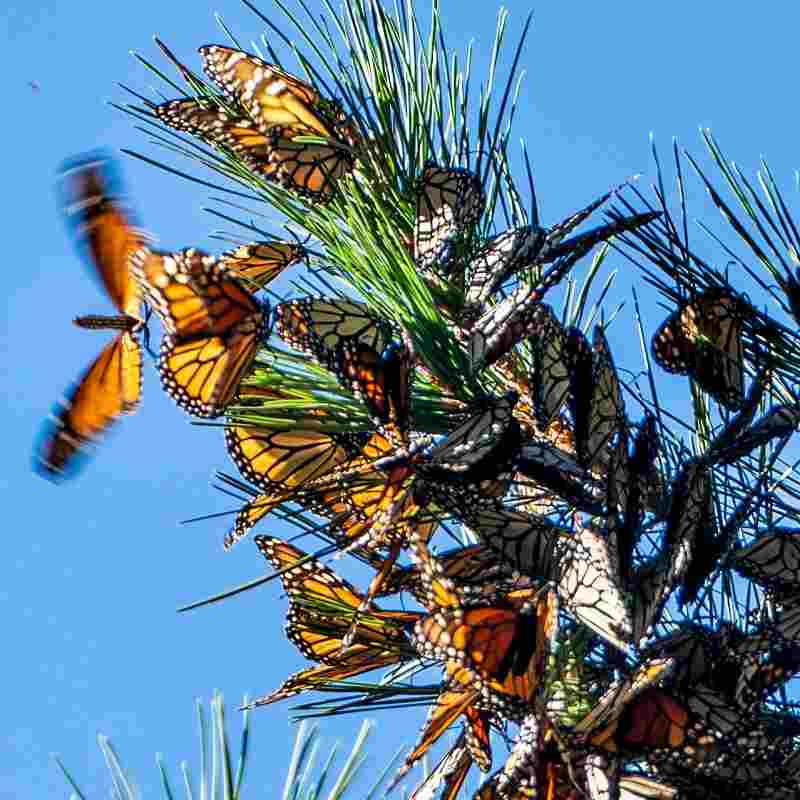11:04 JST, July 22, 2022

Monarch butterflies cluster together at the Monarch Butterfly Sanctuary in Pacific Grove, Calif.
11:04 JST, July 22, 2022
The migratory monarch butterfly, a North American icon with a continent-spanning annual journey, now faces the threat of extinction, according to a top wildlife monitoring group.
Thursday’s decision by the International Union for Conservation of Nature to declare the species endangered comes as years of habitat destruction and rising temperatures have decimated the fluttering orange itinerants’ population.
The species’ numbers have dropped between 22% and 72% over the past decade, according to the new assessment. Monarchs in the Western United States are in particular danger: The population declined by an estimated 99.9%, from as many as 10 million butterflies in the 1980s to fewer than 2,000 in 2021.
“It is difficult to watch monarch butterflies and their extraordinary migration teeter on the edge of collapse, but there are signs of hope,” said Anna Walker, an entomologist at the New Mexico BioPark Society who led the butterfly assessment.
The loss of monarchs underscores a looming extinction crisis worldwide, with profound implications for the humans who have caused it. One million species could disappear, according to the United Nations, a potential calamity not just for plants and animals but also for the people who depend on ecosystems for food and fresh water.
The IUCN is a network of governmental and nonprofit organizations that comprehensively tracks the status of species. Scientists from around the world work together to produce assessments.
Among butterflies, the monarch is not alone. Butterflies across the West are vanishing as the region gets hotter and drier. According to one recent study, a majority of 450 species across a swath of 11 Western states are dropping in numbers.
But it is the decline of the well-known monarch that has grabbed headlines and caused dismay among many wildlife watchers.
The butterfly is famous for its epic migrations from wintering grounds in Mexico and California across the rest of the continent, signaling a change in season as it fans out into the northern reaches of the United States and Canada.
Despite being able to survive thousands of miles of migration, threats from humans now abound.
Forest clearing to harvest timber and to make space for farms and homes is creeping into its wintering grounds. Pesticides and herbicides threaten not only the insect itself but also milkweed, which monarch larvae need to live.
Yet it is possible that the monarch – which, like many insects, plays a pivotal role in pollinating both crops and wildflowers – could come back from the brink.
Monarch aficionados are replanting milkweed across its migration path. The population of insects can fluctuate wildly, and if conditions are right, the monarchs’ numbers can rebound. Last year, in fact, was a bumper year for the butterfly.
“People recognize the monarch,” Walker said. “People love the monarch. So that gives us an opportunity to do the outreach and get people on board.”
But climate change, triggered by the burning of fossil fuels and other human activity, is making recovery harder as drought scorches areas along its migration routes and as storms strike its overwintering spots.
“Climate change is going to be a larger and larger issue for the species,” Walker said.
The endangerment declaration focused on the migratory monarchs of North America, and did not include more stationary populations in southern Mexico, Central America, northern South America and the Caribbean.
Despite the dangers the butterflies face, wildlife officials in the United States have yet to grant federal protections for the monarch under the Endangered Species Act.
In 2020, the U.S. Fish and Wildlife Service said the butterfly’s decline is sharp enough to warrant placement on the endangered species list. But the agency declined to do so, saying other species should take priority.
The latest update to the IUCN’s Red List of Threatened Species also found that all 26 species of sturgeon, an armor-clad, spindle-shaped fish found from the rivers of Russia to the basins of Alaska, are at risk of extinction.
Sturgeon declines are steeper than once thought, the group found, as dams and warming waters undercut the fish’s reproduction and poaching for its meat and caviar persists. One species, the Yangtze sturgeon in China, can no longer be found in the wild.
But it’s not all bad news: Scientists found that the number of known tigers in the wild has risen, from anywhere between 3,726 to 5,578.
Scientists have gotten better at tallying the number of big cats, while some wildlife officials in Asia have strengthened protections for the top predator. There are signs of recovery in China, India, Nepal and Thailand, according to Dale Miquelle, tiger program coordinator for the Wildlife Conservation Society.
Still, the destruction of jungles and continued poaching of both tigers and their prey, such as deer and boar, remain long-term threats. Tigers may now be gone for good in Cambodia, Laos and Vietnam, Miquelle said.
“There’s evidence that things are getting better,” he said. “But we all recognize that the successes and the progress is very fragile.”
"News Services" POPULAR ARTICLE
-

American Playwright Jeremy O. Harris Arrested in Japan on Alleged Drug Smuggling
-

Japan’s Nikkei Stock Average as JGB Yields, Yen Rise on Rate-Hike Bets
-

Japan’s Nikkei Stock Average Licks Wounds after Selloff Sparked by BOJ Hike Bets (UPDATE 1)
-

Japan’s Nikkei Stock Average Buoyed by Stable Yen; SoftBank’s Slide Caps Gains (UPDATE 1)
-

Japanese Bond Yields Zoom, Stocks Slide as Rate Hike Looms
JN ACCESS RANKING
-

Keidanren Chairman Yoshinobu Tsutsui Visits Kashiwazaki-Kariwa Nuclear Power Plant; Inspects New Emergency Safety System
-

Imports of Rare Earths from China Facing Delays, May Be Caused by Deterioration of Japan-China Relations
-

University of Tokyo Professor Discusses Japanese Economic Security in Interview Ahead of Forum
-

Japan Pulls out of Vietnam Nuclear Project, Complicating Hanoi’s Power Plans
-

Govt Aims to Expand NISA Program Lineup, Abolish Age Restriction



















